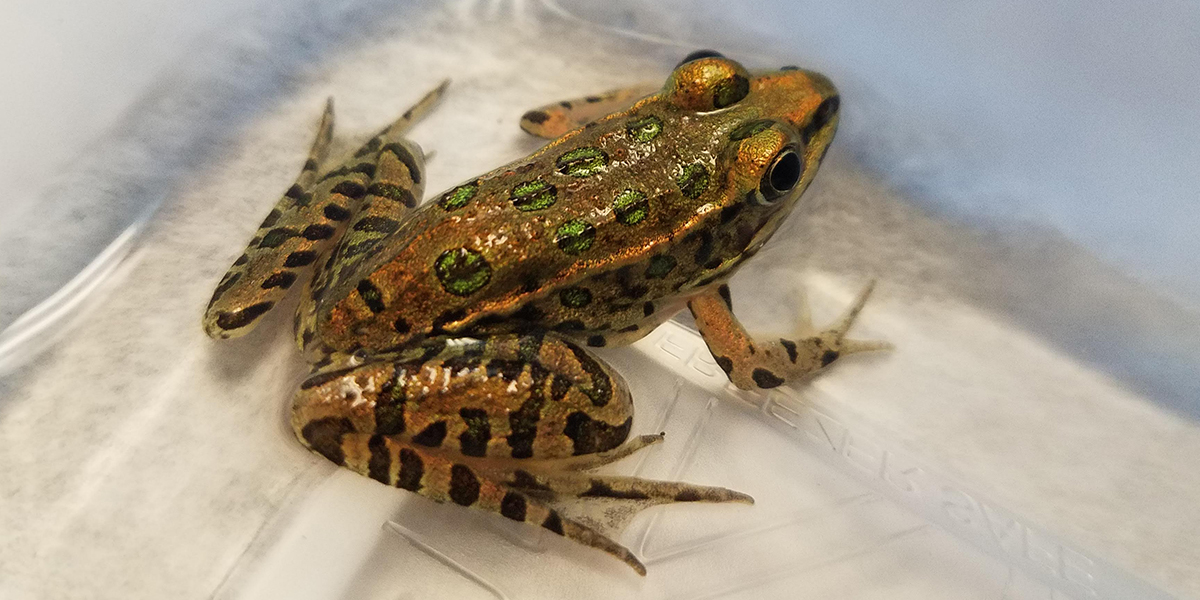How to Survive in a Constantly Changing Environment? Measuring Leopard Frog Responses to Drought
Apr. 10th 2023Since 1900, Vermont’s precipitation has increased by 21 percent and become increasingly variable. Although it is raining more, much of this is caused by more intense storms, not consistent showers. This is only expected to be exasperated as climate change shapes the new normal.
Vermont is not the only place being impacted by variable precipitation patterns due to ongoing climate change. Across the globe, droughts and heavy storms are not just predicted, but expected. In addition to the drastic impacts these changes have on human communities, natural communities must be able to adapt to these new conditions, demonstrate flexibility, or both, in order to persist.
Precipitation-fed water sources such as vernal pools and seasonal wetlands are particularly vulnerable ecosystems, especially to drought. These ecosystems are bustling in the spring as snowmelt and rain drain into the seasonal pools, supporting many young amphibians and other wildlife.
As these ecosystems change, amphibian populations that rely on them are threatened. Many amphibians use a biological tactic called developmental plasticity to adapt to environmental stressors. To do this, amphibians set their larval stage traits on a new trajectory based on the cues they perceive from the environment around them.
Amphibians can use this strategy to survive variable precipitation as they develop, but it can lead to trade-offs with other important traits such as body size and ability to fight off infections later. These trade-offs can arise as a result of carry-over effects from developing under more stressful conditions.
Researchers from universities across the United States including Vanderbilt University, the University of Pittsburgh, University of Nevada Reno, and the University of Massachusetts conducted a study to determine the impacts of pond drying on northern leopard frogs in Vermont and Pennsylvania and southern leopard frogs in Tennessee and Louisiana.
At each study site, researchers raised tadpoles in three different simulated pond drying treatments—constant water level, slow drying, and fast drying. The researchers assembled nine tanks at each site (three replicates of each treatment). They measured water temperatures and frog growth rate, mortality rate, and mass.
Once the tadpoles metamorphosized to frogs, researchers moved the frogs to indoor facilities. Once inside, they measured the frogs’ developmental responses to pond drying and carry-over effects such as juvenile growth rate and multiple immune defenses—antimicrobial peptides (AMPs), response to Batrachochytrium dendrobatidis (Bd, a lethal pathogen) exposure, and cellular immunity.
Responses to treatments varied between sites and species, but in all populations, the drying treatments decreased either growth rates, juvenile survival, disease resistance, or a combination. In the drying treatments, mean daily temperature ranges were wider than for the constant water level treatment at all sites.
“Because the response to pond drying wasn’t consistent between species and location, we think it’s important to study many populations when considering strategies to mitigate ongoing climate change effects instead of extrapolating from one population to represent a whole species,” explained co-lead researcher Emily Le Sage. “Our findings confirm that more frequent droughts are likely impacting these amphibian populations given fewer frogs metamorphosing and more severe infections after rapid drying conditions.”
In Vermont, tadpoles in the constant treatments were up to twice as likely to survive through metamorphosis as the tadpoles in the slow- and fast-drying treatments. The frogs in the drought treatments were smaller after metamorphosis and had lower larval growth rates. Further, Vermont northern leopard frogs were more susceptible to mortality from Bd infection compared with the Pennsylvania population.
Additionally, frogs from the drying treatments had shorter development times and exhibited more diverse skin bacteria. These frogs’ skin contained less of the bacteria that can fight against the fungal pathogen, Bd, and they were less able to clear Bd infections. In all, the findings suggest increased drought caused by climate change could reduce juvenile success in northern leopard frogs.
“We didn’t find that either northern leopard frog population displayed developmental plasticity in response to drought,” shared Le Sage. “This reaffirms what other studies show—that these populations experienced decreased survival instead.”
Pond drying likely coincides with other environmental stressors such as warmer temperatures, lower food availability, increased competition, and reduced water quality. None of these stressors were tested in this experiment but could increase the severe impacts drought has on amphibian populations.
 ecoNEWS VT
ecoNEWS VT